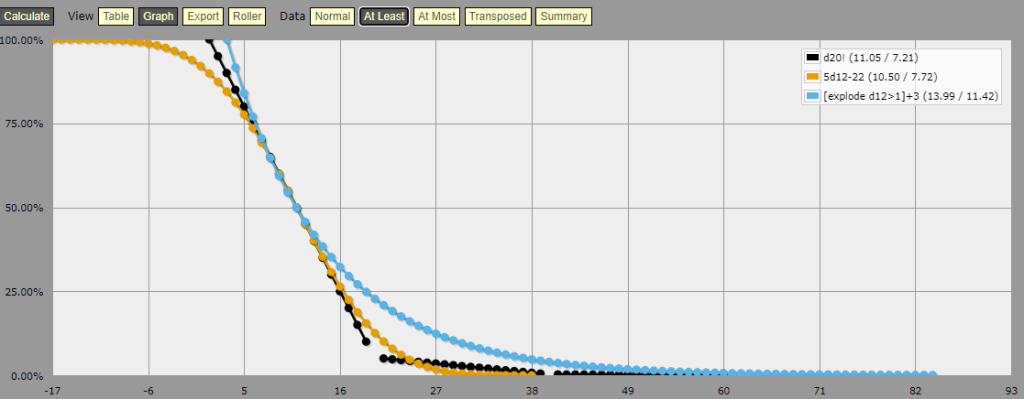As we saw last time, the tail of a normal distribution falls approximately as which makes the EHP in the right tail grows approximately as
(up to some scaling). A gentler curve would be
and
respectively: a geometric distribution.
Exploding dice
In fact, there is an existing die concept that roughly implements a geometric distribution: the exploding die, as used in games such as Savage Worlds (although in this series we are only analyzing binary succeed/fail outcomes). In short, if we roll the highest number on the die, we roll the die again and add it to the total. We keep adding dice as long as we keep rolling the highest number.
Let’s go back to the last graph of last time where we compared d8+6 with 3d6, and replace the standard d8 with an exploding one. (AnyDice.)

Whereas previously the d8+6 couldn’t score higher than a 14, the explosion means that the graph continues to the right, and in fact, the EHP now ramps up slower than the normal-ish distribution produced by 3d6 (remember, the EHP versus d8+6 used to go to infinity at a 15 needed to hit). That’s great!
Unfortunately, there are still some severe shortcomings. First, the curve is kind of lumpy, not helped by the fact that it’s not possible to roll certain numbers such as 14. It turns out that exploding dice only very roughly follow a geometric distribution.
Second, compared to a true geometric distribution, the “half-life” of the curve is too short compared to the behavior near the 50th percentile. We’ll discuss this in more detail in the next part.
Third, both of these problems get worse as we go to larger exploding dice. Here’s the EHP comparison if we try to explode the d20 from last time versus the 5d12–22 that we compared it with. (AnyDice.)

Finally, standard exploding dice don’t give us a great deal of control over the width of the distribution, and thus the precision of our modifiers. After all, there are only half a dozen or so types of standard dice.
Actual geometric dice
It’s possible to implement an actual geometric distribution and not just a rough approximation using physical dice; in fact, it’s the canonical way to define a geometric distribution in the first place. Here’s one that looks similar to both of the previous curves around the 50th percentile. (AnyDice. Note that the chained explodes are just to get past the default limit on the number of times the die can explode.)

Here’s the corresponding EHP plot:

Zoomed in with the 50th percentile near the left edge:

And on a logarithmic vertical scale, on which the geometric die becomes a straight line:

It’s a perfect geometric distribution, it’s nice and smooth, and the EHP ramps up much more gracefully in the right tail compared to the other two distributions, despite being similar below 13 or so.
Now, we don’t want to be using the upper portions of the graph too often; after all, low chances to hit generally aren’t fun. However, even if we aren’t willing to tolerate anything below a 25% chance to hit, we can delay the point at which this happens from a 16 needed to-hit on a d20 to about a 19 on a geometric die with similar behavior near the 50th percentile. That’s around a 50% increase in distance from the 50th percentile to play with, or in terms of D&D 5e, the equivalent of a legendary armor enchantment.
There’s just one problem with this die: the ergonomics are absolutely horrible.
Here’s how this die works: roll a d12. Keep rolling it until we roll a 1. Our result is the total number of dice we rolled (+3 to put the 50th percentile in about the same place as the other curves). Not only do we have to roll 12 dice on average, we have to roll them one-by-one. Nobody has that kind of time!
What now?
What we would like is something that follows a geometric distribution more closely than an exploding die, but doesn’t take as long to physically roll as the canonical method of generating a geometric distribution. That will be the subject of the next part.